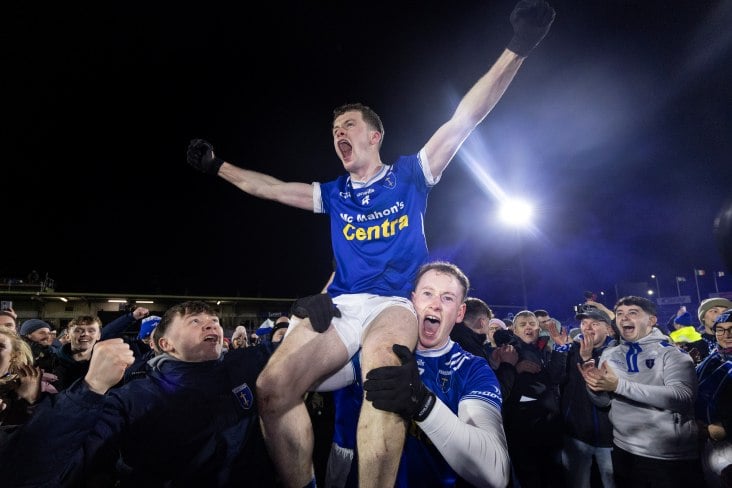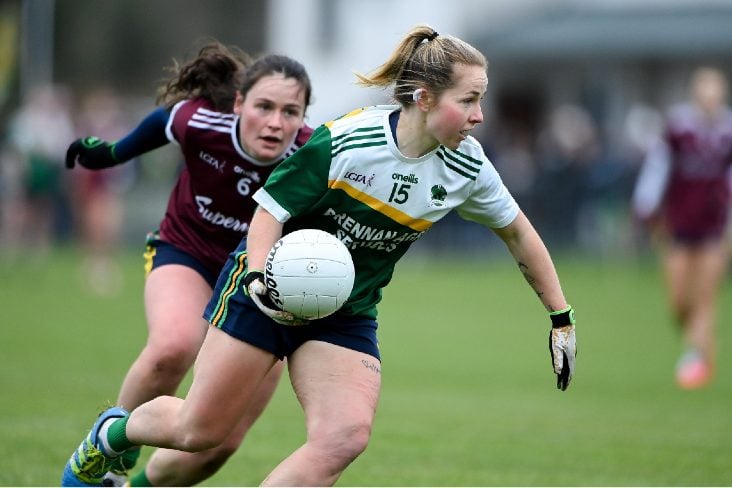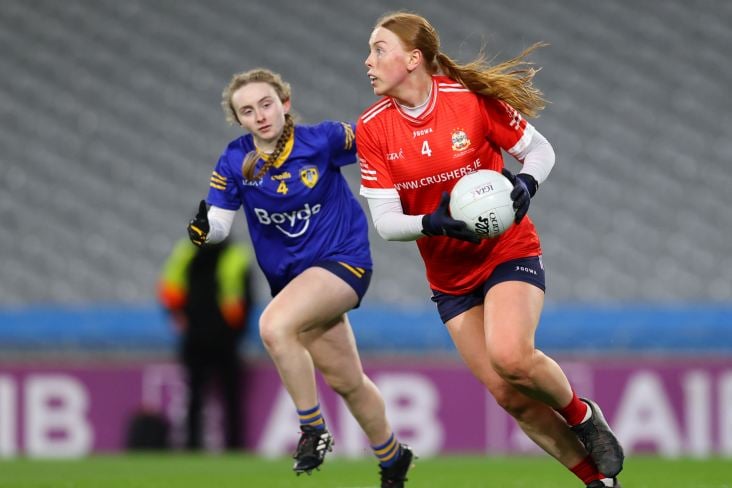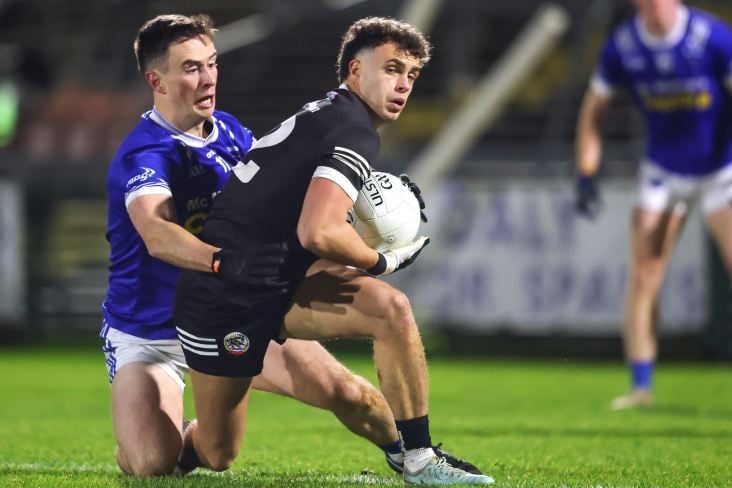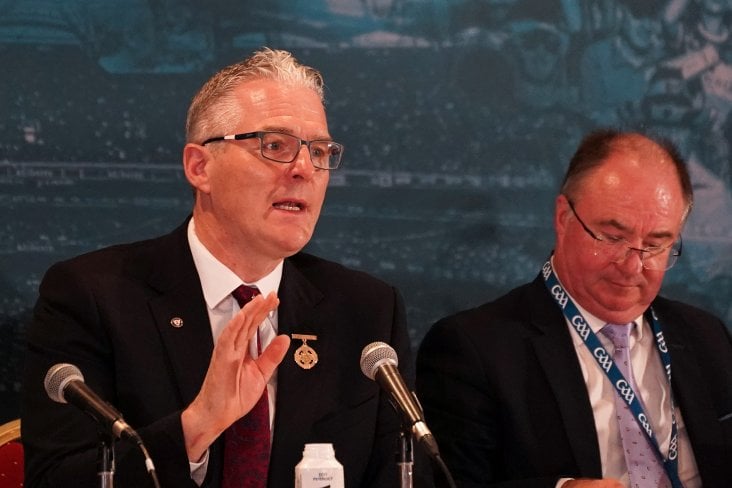Flaherty, Johnny
June 19, 1992
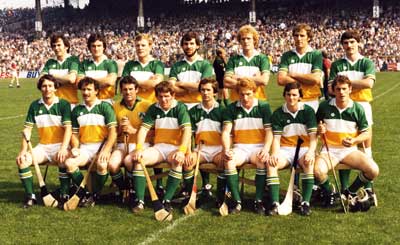
Offaly All Ireland Hurling chamoins 1981.
Front L-R: Tom Donoghue, JOHNNY FLAHERTY, Damien Martin, Padraic Horan, Ger Coughlan, Pat Carroll, Mark Corrigan, Brendan Bermingham.
Back L-R: Paddy Kirwan; Pat Fleury; Joachim Kelly; Liam Currams; Pat Delaney; Eugene Coughlan; Aidan Fogarty.
Johnny Flaherty
THE OFFALY MASTER STILL GOING STRONG AND STILL ATTACHED TO THE HURLEY
In his playing days with Kinnitty and Offaly, Johnny Flaherty wasn't so much a pocket dynamo but rather a tidy explosive device with a short fuse. Regularly exploding at devastatingly opportune moments during the biggest games in the hurling calender, it's four years now since he hung up his hurling tackle. Discerning analysts of the game's recent high profile artisans will point that that's probably the only tackle.
At his prime, one of the most adept wielders of the caman that ever played the modem game, his association nowadays with the most ancient of sporting instruments is largely confined to their manufacture. Approaching forty-three years of age, where once he carved open defences with the stick, Johnny Flaherty is now deeply involved in the business of carving and shaping camans for others to do likewise. After many seasons engaged in blitzing apart rearguard lines, those of the Shamrocks, Galway and Buffers Alley among others, it's appropriate that the 1988 "peoples champion of Offaly should now employ his skill as a hurley manufacturer to make available to his successors an object with which great skill is conveyed.
Reputedly one of the fastest games in the world of sport, arguably the most skillful, the game of hurling can be a dangerous sport if practiced by enthusiastic amateurs devoid of the basic technique or co-ordination required for personal safety. Few that graduate from the Kinnitty school of hurling are amateurish in their approach or practice of the game. Parishioners there learn the game like Amazonians learn how to paint their faces. A natural, instinctive process, learned on leaving the cradle, wise to the imitators and wary of the exhibitionists, the number of seriously injured hurlers from Kinnitty over the years would make a subs bench a lonesome spot. In common with the pack, Johnny Flaherty played just as he was taught, honestly, hard but fair. He was never a man to be found in the Doctors Den. His career, in fact, was injury free, a measure of his artistry, his fitness and his toughness. A good survivor but an even better score- getter.
In fairness, with a spice of objectivity Flaherty enjoyed a running start to his career in the game he still loves. His club provided the young Flaherty with the best possible springboard to launch his skills on a then burgeoning but still unsuccessful Offaly inter county scene. Kinnitty had been the club of the great Offaly and Leinster hurler Pat Spain. It had no difficulty in consolidating it's lofty position among the elite hurling clubs of the county. It was the perfect umbrella organisation under which players like Johnny Flaherty, Paddy Delaney, Ger Coughlan and Mark Corrigan could fulfil their obvious early promise as underage players.
Flaherty's promise was apparent from as early as 1957 when he won his first juvenile hurling medal with the club. Small in stature but with an innate genius that couldn't be masked, his ability to play anywhere, score anywhere made him a manager's delight, a player's player and a veritable icon for youngsters coming after him on the domestic scene. Under the watchful eyes of a guardian-like club committee who selected the team, his ability blossomed quickly and with great effect. A senior club debutant at 17, the county were to benefit from the precocious skills of the emerging teenager. Outings at county minor, under 21 and senior level followed in due course. Back at home Kinnitty folk didn't bat an eyelid. They had already earmarked him down as one of the club's most naturally gifted hurlers. Johnny Flaherty was, in fact, to establish himself, not alone as a big fish in a small hurling pond, but as a gargantuan figure in the larger sphere of the creme de la creme drawn from North, South, East and West of the country.
As a master of hurling in the making, Flaherty also was reared in good company, alongside equally fine prospects. When Kinnitty with Flaherty on board, won the County Junior championship in 1966, players like Mick Cleare and Eddie Moyles provided the perfect foils for comrade Flaherty's cut and thrust manoeuvres. The win heralded a blissfully successful sojourn with Kinnitty, a period which, between 1966 and 1984, would reap seven county championship medals in all for the Kinnitty King.
Meanwhile, his reputation as a senior player-elect for his native county grew by the game. County Under 21 honours like minor before them were to elude him however. He was bitterly disappointed when in the summer of 1967, he figured prominently on the Offaly under 21 team that were beaten by favourites Dublin in that year's provincial decider. "We weren't as disappointed as we might have been. The lads and the whole county, I reckon, believed that we were truly making shapes at that time. We began to seriously address the question of winning titles", recalls the former All Star, who as well as supplying the hurling fold with top class hurling sticks, also doubles up as a respectable insurance businessman with a base in Tullamore, eighteen miles from his home parish but a new home to him, wife Margaret (nee Kirley) and daughters Claire and Shauna.
A Leinster Railway Cup medalist in 1981, Johnny and family moved from Kinnitty, "where hurling was the only language spoken" to Tullamore seven years ago. Four years ago, the affable Flaherty trained his adopted club to a Junior hurling title. It was a hugely significant achievement for the largely football orientated club. In quick succession, Tullamore moved through the ranks, up through Intermediate to the lofty heights of senior hurling status, a grade they currently play their trade. For fifteen years or so, prior to '88, hurling had been the poor relation in the Tullamore area. Not anymore though. Tullamore supporters will tell you, that the one time joker of the Offaly camp was the man largely responsible for hurling's rise to prominence in Tullamore town over that period in the late 'eighties. Present young stars like under 21 county players Kevin Martin and Mark Gallagher plus Andy Hoctor would likely as not testify to that accreditation.
Though he has been known to have been employed on various occasions in all sectors of the field by Kinnitty, it was as a gem up front for his club and county that messr. Flaherty gained nationwide acclaim: the sort of player no comer back wanted to see manoeuvring in his direction as the time came to take up their respective berths just prior to the throw-in. Flaherty was a nightmare for defenders, even those pitted against him in training. His darting runs with the sliotar nestling briefly in his left paw, his sprints into space on the blind side of ball-watching opponents were hallmarks of his game. Defenders hated having to watch him for a full seventy tortuous minutes. The fans could have watched him for much longer though.
Standing 5 foot 7 inches and tipping the scales at 11 stone 7 points, he still togs out in a business suit like an All Star emerging from a packed dressing room of ragged juveniles. Flaherty carries around with him that same indefinable aura which encircled his perfect frame each time he cut a dash on the hurling field. It was a dash that helped earn him six county senior championship dues in 1967, '78,'79, '82, '83 and 1984. Sadly though even his mercurial skills and allies on the Kinnitty side failed to pull a Leinster club title out of the bag. Johnny Flaherty may have ploughed many furrows on the hurling field and emerged relatively unscathed but he wasn't over endowed with the love and kindness of Lady Luck.
Kinnitty, in Flaherty's day, were a great unit, very spirited and with an abundance of talent but there were many hurling powers in sight during the club's purple patch in the mid eighties. Kinnitty were unlucky, and accordingly so too was Johnny. While he was on board, the Offaly kingpins lost three Leinsters. The Kilkenny greats of Ballyhale Shamrock, Wexford's Buffers Alley and Saint Martin's also all inflicted defeat on little Kinnitty when a Leinster crown looked like theirs by right. Few would argue with the suggestion that players like Flaherty 'OUGHT to get the hold of a provincial club medal. Justice shouldn't have it any other way.
While his failures on the Leinster club front represented the down side of hurling life for the one-time deadly goal-poacher, there were infinitely more ups to balance things out. When the Dermot Healy trained Offaly side blazoned their way to an historic first ever Leinster senior championship title in 1980, the man manning the left comer spot was the bould Johnny. Beside him, the equally spirited Padraig Horan and further across Paddy Kirwan. A dream offensive line. The pity of it was that only nine thousand fans turned up to watch the turn-up in the making. For those lucky to have been there, Flaherty's 2-2 personal tally on none other than Kilkenny's John Henderson was surely a joy to behold. History was made, and Flaherty was part of it.
Having spent five years in the early 'seventies in America, the glory of 1980 realised a sweet return for the then mechanic and 'erstwhile Bord na Mona employee. Better was to come however. Flaherty was, at the turn of the eighties, part of a very special team. Skillful, hugely committed and blessed with the talents of such as Joachim Kelly, Liam Currams, Aiden Fogarty and Paddy Delaney, Offaly not alone retained their Leinster championship in'81 but went on to win the All Ireland that self same year.
For Flaherty personally, the All Ireland decider proved to be Roy of the Rovers stuff. A goal nicked by him from a Brendan Birmingham assist in the last moments buried Galway's dreams. Niall Mclnemey and Michael Conneelly could only look on helplessly as the peeked dynamo rocketed the sliotar from close range to the net. All in all, it couldn't have happened to a nicer guy!
Taken from Hogan Stand magazine
19th June 1992
Most Read Stories

